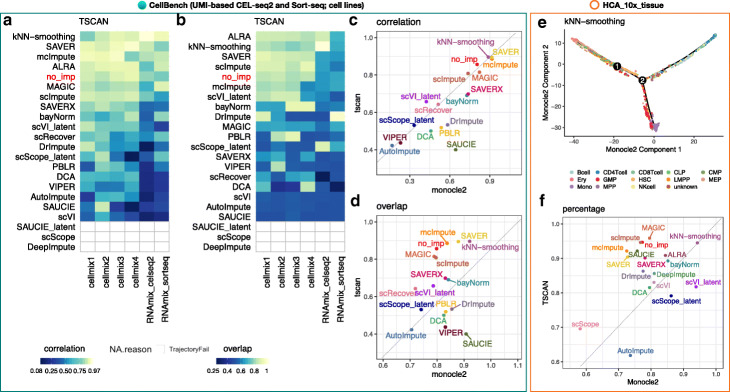Fig. 5.
Impact of imputation methods on inferred trajectories for pseudotime analysis. a Heatmap showing the Pearson correlation coefficients (PCC), denoted as correlation, between the ranks of the inferred trajectory using TSCAN [54] and the rank order of the cells where we know the true trajectory (or ordering) of the cells, using the six RNA mixture and cell mixture datasets from CellBench [18]. White areas with gray outline in a and b indicate that TSCAN failed to infer trajectories from the imputed profiles. b Heatmap of the proportion of cells on the inferred trajectories from TSCAN that correctly overlap with the cells on the branch where we know the true trajectory of the cells using the same data as a. c The comparison of the correlation and d overlap averaged across datasets using Monocle 2 [53] (x-axis) and TSCAN [54] (y-axis) as the trajectory reconstruction method. e An inferred trajectory from Monocle 2 using N=6941 bone marrow cells from the HCA_10x_tissue that were imputed using kNN-smoothing [27]. Colors represent computationally defined cell types using bulk RNA-seq data (see the “Methods” section for details). f Here, we compare the estimated pseudotime to the level of differentiation for each pair of bone marrow cells. For instance, for the pair of cells A and B, if cell A is a hematopoietic stem cell (HSC) (we assign it as differentiation level 1), cell B is a multipotent progenitor (MPP) cell (we assign it as differentiation level 2), and the inferred pseudotime for cells A and B is tA and tB where tA<tB, then we call it “correctly ordered.” The percentage of the correctly ordered cells averaged across all possible cell pairs serves as the assessment measure considering both Monocle 2 (x-axis) and TSCAN (y-axis)

